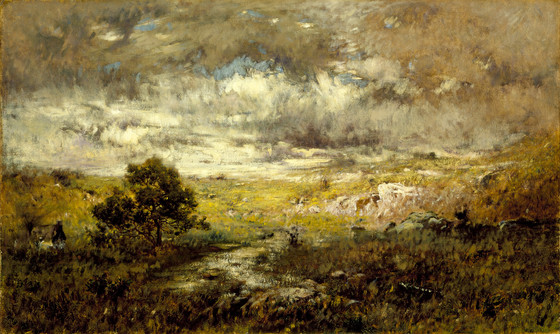Eliot Clark referred to this landscape as "one of the most dramatic and powerful pictures painted by Wyant," expressive of "the unrelenting and irresistible force of nature." Wyant depicted a desolate...
Eliot Clark referred to this landscape as "one of the most dramatic and powerful pictures painted by Wyant," expressive of "the unrelenting and irresistible force of nature." Wyant depicted a desolate land, devoid of any human presence, with only one tree sturdy enough to survive, and the painting was mistakenly referred to in 1912 as No Man’s Land. Storm clouds move quickly over the wild marshy land, solitary stream, and ragged rocks, which cast threatening, dark shadows. While Wyant was preoccupied with light, atmosphere, and weather, Any Man's Land is one of his stormiest landscapes. His earth-toned palette has become even more somber, and his colors--browns, yellow ochers, grays, dark greens, blacks, and white--serve as visual equivalents of nature's ominous mood.
The loose brushwork in the artist's late paintings is usually attributed to the physical disability he suffered after his stroke. Any Man's Land, however, demonstrates that Wyant's late painterly handling was not a result of technical inability but was deliberately employed as an expressive element. The forceful strokes in the clouds and sky echo the movement of the threatening storm, and the vigorous scumbling of the rocks and distant terrain express the wildness of the land. Air and earth seem to merge as the wind whips through, and all becomes ethereal. So removed from strict representation had Wyant become that his art verged on abstraction.
Wyant's brushwork and emphasis on mood rather than place would date this as a late work. The art historian Robert S. Olpin places it in the artist's last years, dating it about 1887-92. A painting with the same title was exhibited in the 1880 annual exhibition of the Society of American Artists, however, and the notices the exhibited landscape received in several newspaper reviews accord with the appearance of the museum's painting. Any Man's Land therefore was painted much earlier than previously considered and demonstrates that Wyant's turn toward a personal, abstract art began earlier than art historians previously thought.
More...



